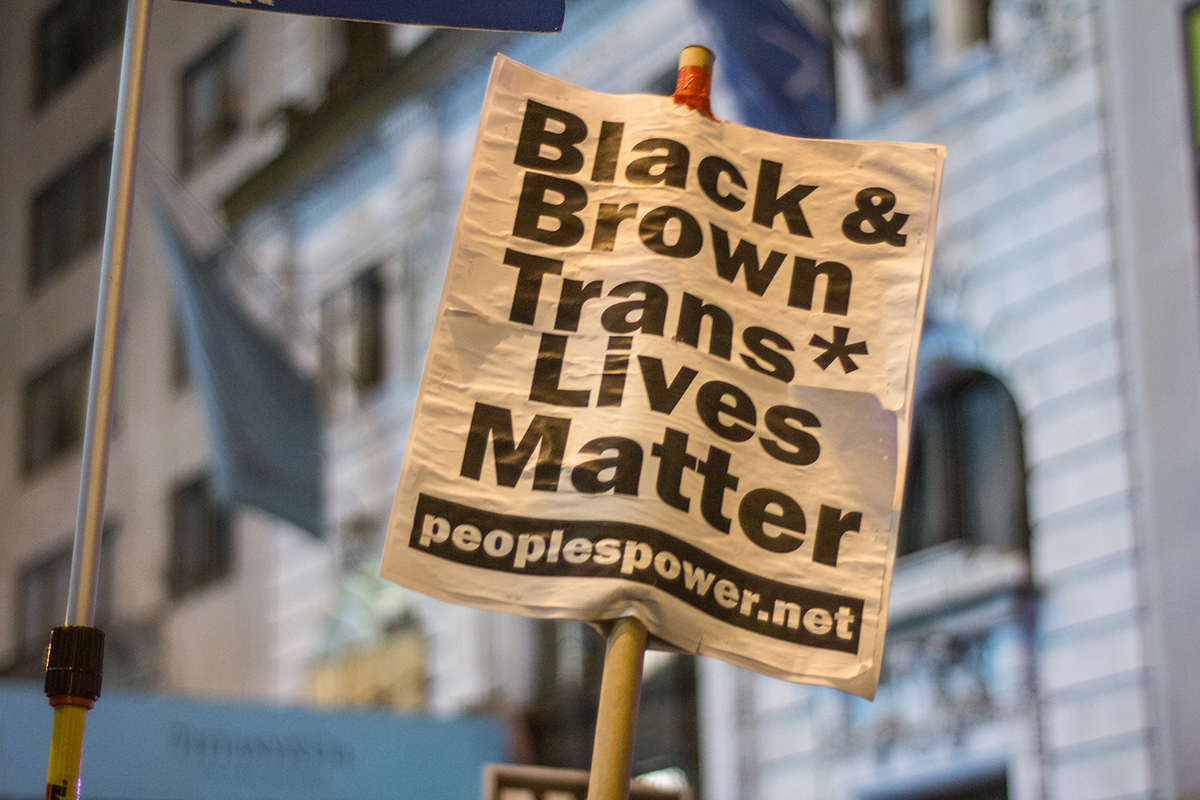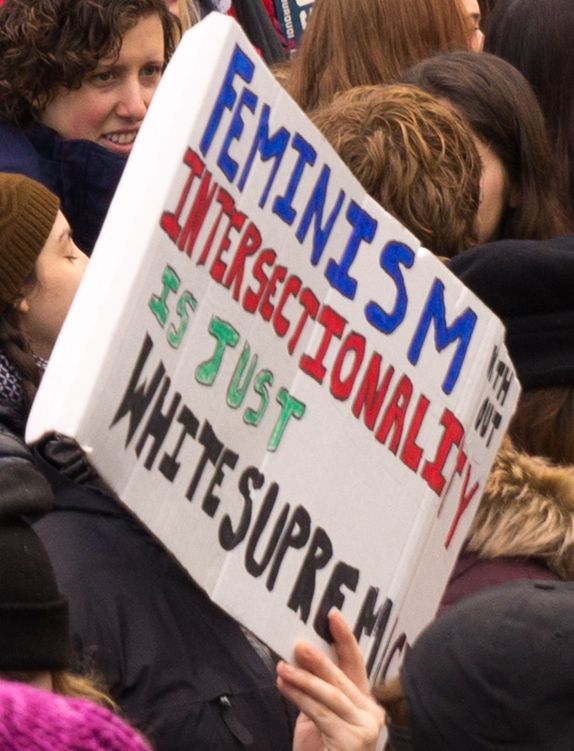Education
The Illiberal Logic of Intersectionality
The claim that intersectionality can be fully separated from radicalism and opposition to free speech remains unconvincing.

A spate of articles about intersectionality have been published recently—two at Heterodox Academy from Ian Storey and Chris Martin and another at the Atlantic from Conor Friedersdorf. These three authors seek to challenge what appears to be a reflexive hostility among conservative and centrist thinkers to the ideas of intersectional theory. Broadly speaking, they all agree that intersectional principles do not necessarily pose a threat to the free speech and that intersectionality is a useful conceptual framework, as it allows us to better understand the unique set of problems faced by people with intersecting identities (e.g. black women, gay Hispanic men). Storey and Friedersdorf, moreover, argue that the fact that campus activists have used intersectionality to suppress speech proves only that the tactics of the social justice movement can be illiberal, but not that the theory is itself at fault for illiberal activist conduct.
Thought-provoking and insightful though their essays were, the claim that intersectionality can be fully separated from radicalism and opposition to free speech remains unconvincing. That is not to say that all the claims of intersectionality should be retired: it is certainly true, for instance, that the average life experience of a poor white female will differ substantially from that of a wealthy black male. Some form of intersectional thinking would enable us to understand such distinctions.
Further, Kimberlé Crenshaw (the Columbia Law professor who coined the term ‘intersectionality’) certainly deserves credit for pointing out a debilitating blind spot in the American legal framework: namely, its inability to consider ‘black women’ as a protected class of people, as was witnessed in the 1976 Emma DeGraffenreid case. DeGraffenreid, a black woman, had sued General Motors for discriminating against her, but the court found that, since GM did not discriminate against blacks or against women, it could not be held liable for discrimination against black women. In his article, Chris Martin rightly laments the court’s decision, which stated that plaintiffs “should not be allowed to combine statutory remedies to create a new ‘super-remedy’ which would give them relief beyond what the drafters of the relevant statutes intended.” In other words, the court found that U.S. anti-discrimination law protected blacks and women, but not black women. The court finding was a flagrant violation of the spirit of the 1964 Civil Rights Act. We have Crenshaw to thank for highlighting this injustice.

Nonetheless, despite enabling a greater understanding of intersecting identities and highlighting certain flaws in our legal system, intersectionality’s logic contains the seeds of illiberalism and censorship. Intersectionality employs dangerous and imprecise language, encourages ideological uniformity (and conformity), fosters groupthink, and necessitates radicalism. These undesirable characteristics are all likely—if not necessary—consequences of the foundational tenets of intersectional theory. Let me take them in turn.
I. Intersectionality Employs Dangerous and Imprecise Language
The primary claim of intersectional theory is that there are multiple axes of oppression (or subordination) to which people can be subjected. Crenshaw and her co-thinkers (including Patricia Hill Collins and bell hooks) do not use the phrase “axes of disadvantage” or of “misfortune” nor anything to that effect; they specifically refer to a wide range of social phenomena as “oppression,” thereby implying that some groups (or structures of power) actively oppress other groups. Intersectional theorists claim that blacks, women, queer people, indigenous people, Hispanics, and the poor are categorically oppressed—that is, at the receiving end of some current (and not just past) systemic injustice; moreover, the intensity of the oppression increases as the number of intersections increase in an individual. Presumably, then, the only people who aren’t oppressed in America are straight, cis-gendered, wealthy, white males.
In his article, Chris Martin elucidates many of the shortcomings of the ‘oppression’ framework. He argues compellingly that intersectionality “posits unambiguous axes of oppression” by ignoring that minorities sometimes benefit from pro-minority discrimination (as with affirmative action policies). He adds that intersectionality fails to consider “the influence of the situation.” “For instance,” he explains, “being African-American might be an advantage when you apply to an undergraduate college, but it might be a disadvantage when you apply for a summer internship.” So certain identities might yield advantages in some places, but not in others.
Other problems with the intersectional framework remain, and they merit elaboration. First, ‘oppression’ is rarely defined rigorously. And it is simply not self-evident that all the various groups purportedly subjected to oppressive power structures in fact suffer from oppression, however defined. Consider men and women, for instance. Men benefit from certain biological advantages (they are stronger on average and can perform hard physical labor with greater ease) but also suffer from biological disadvantages (men make up 80 percent of all people with autism and are 3.5 times more likely to commit suicide than women).
Similarly, social advantages and disadvantages are not evenly distributed between men and women. Men, for example, seem to be severely “underperforming” at the universities: in 2013, women earned “61.6 percent of all associate’s degrees, 56.7 percent of all bachelor’s degrees, 59.9 percent of all master’s degrees, and 51.6 percent of all doctor’s degrees.” One can of course rattle off a list of areas where men are dominant, but my point is that reducing the entire universe of male/female social outcomes to a simple formula in which ‘women are oppressed’ is far too simplistic. Men do better in some areas, women better in others. Both benefit and suffer from different advantages and disadvantages, respectively.
Without engaging here in the debate over whether ethnic minorities are or are not oppressed, suffice it to say that, as in the case of women, it is not self-evident that they categorically are. Asians, Nigerians, and some other non-white minority groups outperform whites on a variety of objective standards like educational attainment, employment rates, and levels of income. Additionally, the idea that blacks are oppressed is not even unanimously accepted by blacks. In a recent article for Quillette, my friend Coleman Hughes drew attention to a “message of black self-creation [as opposed to] the prevailing leftist view that modern systems of oppression recapitulate the overt injustices of the past and therefore constrain black potential.” Hughes also notes that “60 percent of blacks without college degrees say their race hasn’t affected their chances of success.” Many centrist and right-leaning black intellectuals have long advanced similar propositions.
Yet Crenshaw’s intersectional framework is impervious to empirical counter-arguments and dismissive of nuance because it presupposes that most people in the United States suffer from oppression, without ever bothering to define what exactly that word means and seemingly without considering what the people in question think about their own situation. (And of course, one does not need to believe that ‘racism is over’ or that minorities suffer from no disadvantages to lodge criticisms of this sort against intersectionality.)
Intersectionality also posits that all forms of oppression overlap and are “inextricably linked,” which brings me to my next criticism.
II. Intersectionality Encourages Ideological Uniformity and Fosters Groupthink
As alluded to above, the statement that most people in America suffer from oppression is nearly incompatible with nuanced analyses. If one accepts that the intersectional framework is essentially correct, and if one further accepts that blacks are oppressed, then one must necessarily grant the notion that women, gays, poor people, and so on are also oppressed. The oppression axes of intersectionality therefore make it very difficult to make nuanced claims because intersectionalists are committed to the radical-Left interpretation of anything related to race and gender. The logic of intersectionality mandates uniformity of this kind.
The intersectional claim that all systems of oppression are linked is, furthermore, the driving force behind the coalescing of nearly every Leftist activist cause, from Palestinian-liberation-advocacy to pro-choice feminism to LGBTQ activism. All these groups have come together under one massive panoply, and they have all started to employ the same quasi-Marxist rhetoric about systems of oppression and the need for revolution.
We can best see the effects of this kind of awkward coalition-building in the ideology of Black Lives Matter. A movement that purportedly arose to combat police brutality now writes on its website that it “affirm[s] the lives of Black queer and trans folks, disabled folks, undocumented folks, folks with records, women, and all Black lives along the gender spectrum. Our network centers those who have been marginalized within Black liberation movements.” Its policy prescriptions now reflect these broad interests. Thus the dynamics of intersectionality pushed Black Lives Matter into issues outside its original area of interest by committing the movement to far-Left narratives of ‘marginalization.’

And in the universities, where intersectionality is strongest, intersectional professors and student activists often excoriate moderate progressives and non-intersectional Leftists for being insufficiently ‘woke’ or radical. Just look, for instance, at what happened to Mark Lilla, the professor of intellectual history at Columbia, when he spoke out against identity politics in the wake of Trump’s election. Katherine Franke, a fellow Columbia professor, compared him to (white supremacist) David Duke, writing that “both men are underwriting the whitening of American nationalism, and the re-centering of white lives as lives that matter most in the U.S. Duke is happy to own the white supremacy of his statements, while Lilla’s op-ed does the more nefarious background work of making white supremacy respectable.”
Franke, as she reveals in her essay, was writing under the suppositions of intersectional theory, which informed her that any (supposed) attempt on Lilla’s part to obfuscate the truth of American oppression was no less than an attempt at upholding white supremacy. (Lilla has argued that minorities would be better served if liberals focused on electoral politics, but no matter; as far as Frank is concerned, he’s still a white supremacist.) Her accusations and her insistence on ideological uniformity evidently originate in the dictates of her interpretations of intersectionality; this reality complicates the optimism of Friedersdorf and Storey vis-à-vis intersectionality. Which brings me to my next point.
III. Intersectionality Necessitates Radicalism
Suppose intersectionality were true. Suppose, as Crenshaw et al do, that everybody in America save for cis straight rich white men were oppressed. Such a society would be tyrannical, unjust, morally abhorrent—and, for precisely those reasons, desperately in need of radical change. It would be incumbent upon activists, if not upon all morally-righteous people, to radically transform such wretched forms of social organization. If our police forces, court systems, legislatures, universities, and corporations are stained by the filthy sins of misogyny and white supremacy, then some sort of radical or even revolutionary politics would understandably follow.
An article by Sharon Smith at the International Socialist Review is telling; she writes that, “As an additive to Marxist theory, intersectionality leads the way toward a much higher level of understanding of the character of oppression than that developed by classical Marxists, enabling the further development of the ways in which solidarity can be built between all those who suffer oppression and exploitation under capitalism to forge a unified movement.” Thus, intersectionality is made to function at the service of Marxism political projects.
The behavior of people like Katherine Frank (referring to colleagues as no better than Klansmen and neo-Nazis) and of campus activists (shutting down speakers and calling them similarly ugly epithets) makes more sense when one understands the tenets of intersectionality. There are certainly other factors behind such illiberal behavior, but the ideological underpinnings of intersectional censorship cannot be ignored. If allowing intellectual dissent exacerbates injustice and prevents the creation of large, coalition-based movements to combat all the oppression in our society, then it easily (though not necessarily) follows that one should shut down people who challenge these leftist narratives. That is, at least, one potential interpretation of the logical conclusions of intersectionality, which in the end amounts to a ruthless critique of everything existing in our society because it is, according to the theory, too white, too male, too Western.
But Friedersdorf and Storey see no critical link between intersectionality’s radicalism and the behavior of the activists who preach its doctrine. Storey writes that “nothing about intersectionality makes it inherently hostile to open speech and debate.” He explains in his piece that there are “three constitutive parts [of a given social movement]: its issue area, its constituency, and its tactics. Although the three are often profoundly intertwined, no individual component mandates anything in particular about the other two” (italics mine). Put more simply, Storey believes that a movement’s topic of concern, demographic characteristics (i.e. the sorts of people who join the movement), and the methods it uses to advance is claims can vary independently, even if they are often intertwined.
There’s much truth to Storey’s analysis. But in the particular case of intersectionality, it seems clear that its “issue area” (the emancipation of the oppressed) does seem to play a role in encouraging its tactics (demanding immediate emancipation by the means of radical rhetoric and calls for censorship). The intrinsic radicalism of intersectionality fosters a moral culture of extreme urgency. We can see this even in the words of the anti-free-speech activists that Friedesdorf quotes in his piece, who justified shutting down a speaker by arguing that they “now understand how language works, and how it can be used to reproduce the systems of oppression we know we must resist at all costs.” The matrix of intersectionality and censorship is herein demonstrated, belying Friedersdorf’s attempt to separate the two; while censorship is not mandated by intersectionality, the culture of moral panic that intersectionality creates certainly encourages it.
There does seem to be, then, an intimate link between intersectionality’s claims and tactics. The former, in part, inform the latter.
Conclusion
The critiques above have largely skirted around the question of whether the claims of intersectionality are true and, instead, focused on their deleterious social consequences and on the extent to which the consequences can be blamed on the theory. While Storey, Martin, and Friedersdorf are right to say that as a conceptual framework a type of intersectionality could have been helpful, the inherent tendencies and mechanisms of intersectional theory as it has developed must bear some blame for the illiberal behavior of campus activists and for the inability of some intersectional theorists to engage in civil debate with their opponents. And while intersectionality is by no means the only force driving the debasement of discourse (social media also comes to mind), it certainly remains a factor, and a significant one at that. The claims of intersectionality, radical and uncompromising as they are, must therefore be implicated in any analysis of the predicament of our universities, of free speech, and of national discourse in the United States.






